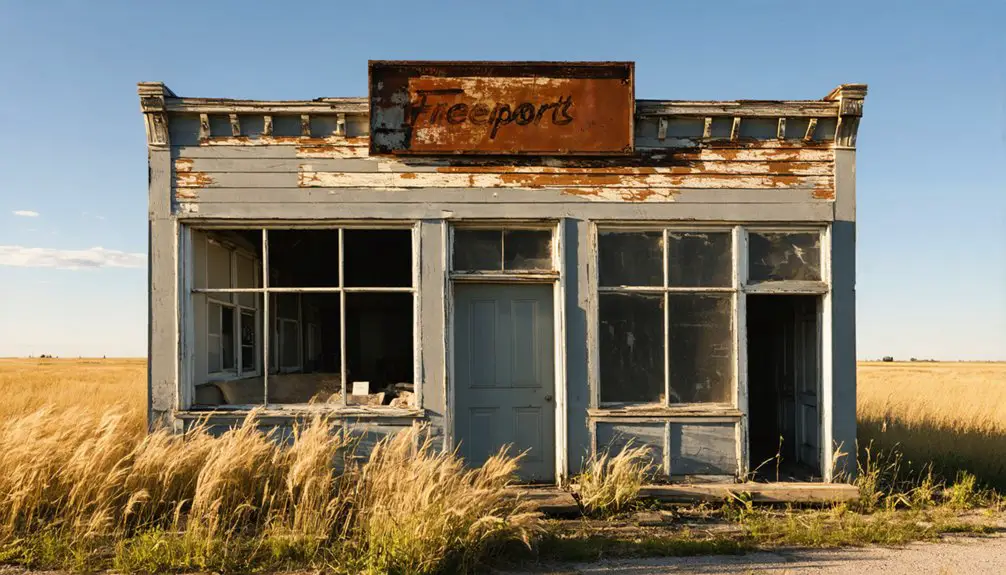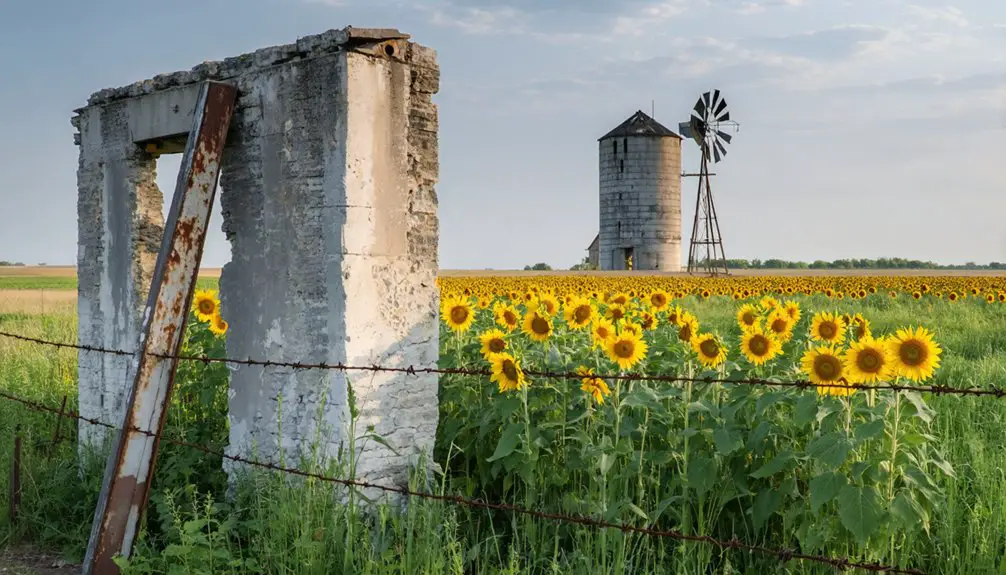You’ll find Freeport, Kansas nestled along the former St. Louis, Fort Scott & Wichita Railway line in Harper County. Founded in 1885, this prairie boomtown quickly grew from 300 to nearly 1,000 residents by 1892, thriving as a commercial hub with over 20 businesses along its bustling Main Street. After the Cherokee Strip opening in 1893, the population plummeted to just 54 by 1895. By 2017, this once-vibrant railroad town stood silent, its weathered buildings and towering grain elevator telling tales of frontier dreams.
Key Takeaways
- Freeport, Kansas peaked at 700 residents in 1892 but declined to just 5 residents by 2010, before officially dissolving in 2017.
- The town’s decline began after the Cherokee Strip opening in 1895, causing businesses to close and residents to relocate.
- Once-thriving Main Street featured over 20 businesses, including grocery stores and lumberyards, supported by two major railways.
- Modern remnants include a preserved Presbyterian Church, towering grain elevator, and small cemeteries marking the town’s historical significance.
- The ghost town originated as a railroad depot town in 1885, competing with nearby Midlothian before becoming a regional commercial center.
The Birth of Two Sister Settlements

While Freeport, Kansas eventually became the dominant settlement, it began as one of two rival communities alongside Midlothian. The Midlothian origins trace back to B.H. Freeman’s trading post, where he established a post office in April 1879. Named after the Scottish term for “Midland,” this pioneer settlement included a school and church. Similar to the Crystal Springs Mennonites, the community maintained its own church to preserve its cultural identity.
The stage was set for Freeport rivalry when surveyors platted the new town on February 27, 1885, just a week before Midlothian’s official platting. By the fall of that year, the post office moved from Midlothian to Freeport.
Surveyor’s maps drawn in February 1885 sparked a contentious competition between neighboring settlements vying for dominance.
You’ll find these sister settlements were divided by Grand Avenue, with Freeport gaining an advantage through its Missouri Pacific Railway depot on Main Street.
Though initial hostility marked their relationship, by March 1886, they’d publicly settled their differences. Midlothian eventually became known as West Freeport, marking the end of their competitive beginnings.
Railroad Prosperity and Rapid Growth
After the St. Louis, Fort Scott & Wichita Railway reached Anthony in 1885, you’ll find Freeport quickly establishing itself around the railroad depot on Main Street.
The railroad development helped transform the landscape from its early days when the land was considered suitable only for buffalo grazing. The town’s accessibility increased further when a second rail line, the Chicago, Rock Island & Pacific, strengthened Freeport’s commercial potential as a regional hub. With railroad expansion bringing economic growth across Kansas, Freeport benefited from the era when standard railroad gauges were adopted in 1883.
Railroad Drives Town Development
When the St. Louis, Fort Scott & Wichita Railway laid tracks to Anthony in 1885, you’d have witnessed the birth of a strategic transportation hub in Freeport, Kansas. Following railroad expansion, the town was platted on February 27, with neighboring Midlothian established just eight days later.
You’d have seen how the railway depot on Main Street quickly transformed Freeport into a bustling center of commerce. The railroad’s presence sparked rapid development as you’d find grain elevators, a steam mill, and various businesses springing up along the tracks.
You’d notice how town founders deliberately planned infrastructure, including roads and public wells, while offering free lots for churches and schools. By 1887, Freeport’s prosperity led to the merger with Midlothian, creating a unified community that maximized its railroad advantages.
Peak Population Hits 1000
The young town of Freeport swelled from 300 to nearly 1,000 residents between 1887 and 1892, transforming from a newly incorporated city into a bustling commercial center.
The town’s population dynamics reflected the opportunities created by two major railways – the Missouri Pacific and the St. Louis, Fort Scott & Wichita line – which made Freeport a crucial hub for regional commerce. Researchers often reference the disambiguation page when studying various Freeport locations across America.
Economic fluctuations spurred growth as diverse businesses emerged to serve the expanding community. You’d have found nine grocery stores, five dry goods shops, three lumberyards, and two grain elevators.
The town’s infrastructure kept pace, with a church and school supporting community life. The 1885 relocation of Midlothian’s post office to Freeport further cemented its position as a thriving regional center.
Depot Anchors Main Street
Steam whistles and clattering wheels announced Freeport’s transformation as the St. Louis, Fort Scott & Wichita Railway’s arrival in 1885 forever changed this Kansas prairie town.
You’d have found the depot prominently placed along Main Street, where it quickly became the heart of local commerce and activity.
The depot history reveals how this strategic location spurred rapid development, with businesses clustering nearby to capitalize on the steady stream of passengers and freight.
You could’ve watched farmers hauling grain to the newly built elevator, while merchants received goods from distant markets.
The depot’s presence sparked construction of a flouring mill and other essential infrastructure, transforming Main Street into a bustling commercial corridor.
The railway connection brought previously unimaginable opportunities, linking Freeport’s residents to a wider world of trade and travel.
Life in a Booming Prairie Town
If you’d visited Freeport during its 1890s peak, you’d have found a bustling prairie town with over 20 thriving businesses including multiple lumberyards, grocery stores, and blacksmith shops serving nearly 700 residents.
You could have stopped at one of two hotels, visited the local bank, or picked up supplies at any of the five dry goods stores along Main Street near the Missouri Pacific Railway depot.
Social life centered around the town’s various gathering spots, from churches and saloons to the local newspaper office where you might catch up on community happenings in The Freeport Tribune.
Like many Kansas settlements, Freeport’s prosperity faded when economic depressions caused businesses to close and residents to seek opportunities elsewhere.
Frontier Business Flourishes
After B.H. Freeman established his trading post in 1878 at Midlothian, you’d have witnessed remarkable business diversity take root in the emerging town of Freeport.
By the time the town was platted in 1885, retail growth had transformed the prairie outpost into a bustling commercial hub.
You’d have found nine grocery stores and five dry goods establishments meeting your daily needs, while specialized shops like meat markets, hardware stores, and drug stores offered everything a frontier settler required.
Four blacksmith shops kept your farming equipment running, and two hotels welcomed travelers arriving via the Missouri Pacific and St. Louis railways.
The town’s strategic location, complete with grain elevators and a railway depot on Main Street, connected you to crucial trade networks and the county seat of Anthony, just 12 miles away.
Daily Pioneer Activities
When dawn broke over Freeport’s bustling prairie streets in the 1880s, you’d find residents already engaged in their daily routines.
Pioneer chores began with feeding livestock and preparing fields, using horse-drawn equipment to work the wheat and corn crops. You’d spend your mornings tending to essential tasks, from mending fences to irrigating fields. Like the farmers in Bell Plane’s apple orchards, many residents dedicated themselves to agricultural pursuits. The nearby town of Waco served as a vital shipping point for local farmers’ produce and livestock.
Your social world centered around the local school, church, and general store. Community gatherings happened regularly, from weekly church services to cooperative harvest events where neighbors helped each other bring in crops.
You’d often stop by the post office to collect mail and exchange news with fellow townsfolk. When evening came, you might join informal gatherings in homes or attend occasional dances, creating precious moments of leisure amid the demanding prairie life.
The Cherokee Strip’s Impact

The Cherokee Strip‘s complex history profoundly shaped Kansas’s economic and demographic landscape in the late 1800s.
The European-American ranchers began using this land extensively for cattle grazing in the early 1880s.
You’ll find that cattle operations initially thrived when the Cherokee Outlet served as prime grazing land, with Kansas cattlemen securing valuable leases through the Cherokee Live Stock Association for $100,000 annually.
Everything changed in 1890 when President Harrison banned grazing, forcing dramatic adjustments in land use.
Over 100,000 eager settlers participated in the massive land run that forever changed the region’s demographics.
When the government opened the Strip for settlement in 1893, you would’ve witnessed a mass exodus from Kansas border towns like Freeport.
As settlers rushed south to claim new lands, Freeport’s population plummeted to just 54 residents by 1895.
Buildings and businesses abandoned Kansas locations, relocating to newly established settlements closer to the former Cherokee Strip, permanently altering the region’s economic foundation.
Final Years as Kansas’ Smallest City
From its peak of 700 residents in 1892, Freeport’s population steadily dwindled until you’d find just 5 people calling it home by 2010.
Population challenges hit hard after the Cherokee Strip opening in 1893, dropping to just 54 residents by 1895.
Economic decline followed as businesses shuttered one by one, though the grain elevator and church remained operational.
What Remains Today

Standing as a silent reflection of its past, modern-day Freeport retains only a handful of weathered structures amid empty streets and overgrown prairie grass.
The ghostly remnants of this once-thriving Kansas community tell a story of historical significance through its abandoned buildings and quiet landscape.
You’ll find these key remaining features:
- A towering grain elevator and silo stand as landmarks against the prairie sky
- The Presbyterian Church building remains preserved
- Two small cemeteries mark the legacy of former residents
- Foundations of old storefronts trace the original town grid
- Rusted playground equipment sits near the crumbling school ruins
With only five residents remaining after its 2017 dissolution as a city, Freeport’s plains and farmland have largely reclaimed the land where a bustling community once stood.
Frequently Asked Questions
What Role Did Native Americans Play in the Area Before Freeport’s Establishment?
You’ll find Native American tribes, particularly the Osage, controlled these lands through an 1825 treaty. They’ve left their cultural significance through trade patterns and resource management before settlers arrived.
Were There Any Notable Crimes or Lawlessness During Freeport’s Boom Years?
Like a blank page in history’s book, you won’t find evidence of significant criminal activity or law enforcement problems during the boom years. Historical records show a stable, orderly community instead.
What Was the Average Property Value During Freeport’s Peak Population?
While exact values aren’t recorded, you’d find property trends during the 1892 peak reflected similar railroad boom towns, with economic factors suggesting urban lots likely ranged from $100-$500 each.
Did Any Famous People or Events Originate From Freeport?
Despite once housing 1,000 residents, you won’t find any famous residents from Freeport. The town’s most notable historical events were its 1885 founding, 1887 incorporation, and final dissolution in 2017.
What Natural Disasters or Severe Weather Events Impacted Freeport’s History?
While records don’t confirm specific tornado damage or flood impact in Freeport itself, you’ll find the town faced typical Kansas severe weather patterns that challenged many similar settlements in the early 1900s.
References
- https://legendsofkansas.com/freeport-kansas/
- https://fhsuguides.fhsu.edu/kansasheritage/harpercounty
- https://freepages.rootsweb.com/~gtusa/history/usa/ks.htm
- https://en.wikipedia.org/wiki/Harper_County
- https://www.instagram.com/reel/C8OLqBZMWwN/
- https://en.wikipedia.org/wiki/Freeport
- http://www.ksgenweb.org/archives/1912/f/freeport.html
- https://www.savethepostoffice.com/post-office/freeport-ks-67049/
- https://legendsofkansas.com/kansas-railroad-timeline/
- https://www.nwmissouri.edu/library/theses/2014/TroutBrent.pdf



